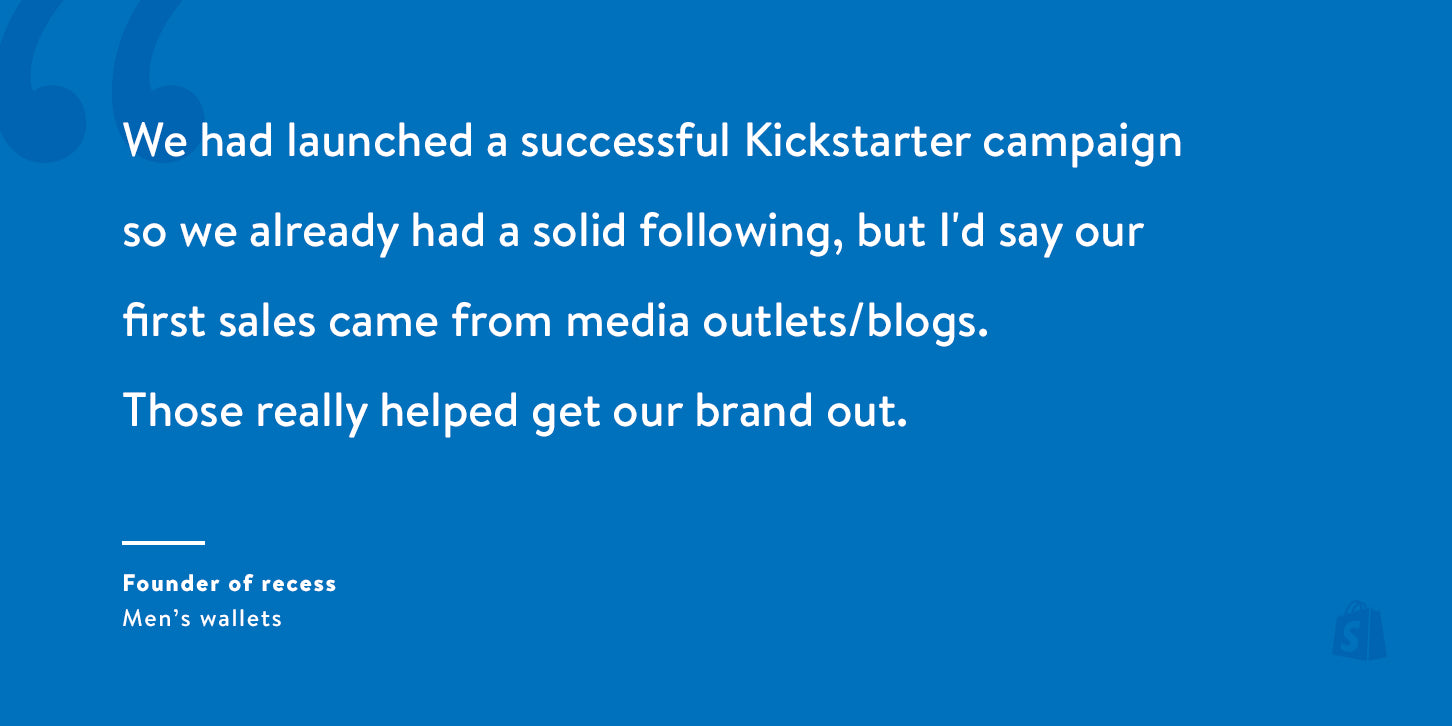Whether you haven't started marketing your new business or have been trying to get sales without any luck, getting your first real customer is a key milestone for every ecommerce entrepreneur.
But marketing takes time and it takes focus.
With literally hundreds of channels and tactics and different ways to promote your business, it can be hard to sift through them all to find the ones that make the most sense for your unique business and produce immediate results.
To add on to that, it's easy to fall into the trap of tweaking your store endlessly in the pursuit of perfection, instead of investing that attention on the most important part: driving traffic to your store.
Why Traffic Is Especially Important For New Stores
As the owner of a new online store, it's easy to fall under the "illusion of improvement", changing brand colors, flip-flopping on fonts, second-guessing your pricing, and getting caught up in the details as you build a business behind closed doors.
Real improvement, on the other hand, is only possible when you expose your business to the world. You can't really know what you're improving unless you establish a benchmark that you can quantify through hard numbers. That's why traffic is so important.
You won’t know if there's any interest in your products if you don’t drive traffic.
You won’t know if your prices are too high if you don’t drive traffic.
You won’t know if your brand resonates with your intended audience if you don’t drive traffic.
That's why I propose a challenge: If your store has already launched, spend the next 30 days focusing on driving traffic above all else.
To help you ramp up your marketing, we have organized some of the most widely applicable ecommerce marketing tactics into a checklist you can use to focus your efforts, along with beginner-friendly resources to learn how to execute them.
We'll start this checklist with free, easy traffic sources to get warmed up, before moving on to more highly targeted marketing that might require you to invest some more time and money.
Be sure to set up Google Analytics in advance and keep a close eye on your traffic as you try each marketing tactic.
With that said, get ready to spend the next 30 days failing fast on your way to your first sale.
Free Traffic Sources: Going After the Low-Hanging Fruit

The first sources of traffic you should consider exploring are the free ones that involve sharing your store manually with your network and relevant online communities.
Since these sources of traffic are so easy to create and are available to every online store owner, they're a great place to start.
Keep the following tips in mind as you tackle these traffic sources:
Consider offering a discount code to entice people to at least check your store out.
Add your store URL to your personal online profiles (such as your Twitterbio or your Disqus profile for blog comments), so that every action you take online has the potential to drive traffic back to your store.
Don't spam the same audience repeatedly with low quality promotional messages.
Tap Into Your Personal Networks

Many entrepreneurs get their first few sales from their personal connections and there's nothing wrong with that.
So share your store on your personal Facebook, Twitter, LinkedIn, Instagram, and Snapchat accounts to announce it to your entire network.
Consider also emailing your closest connections directly to get the word out about your store's launch. Explicitly ask them to donate a share—they don't need to buy from you to show you their support.
While any sales you get this way aren’t going to be as satisfying as when you earn a complete stranger’s trust as a customer, this is a good way to solicit early feedback.
If you don't get any sales from this, don't be discouraged as this is the least qualified source of traffic in this entire list.
Recommended for: Everyone (since we all have friends/family/coworkers), but especially those who are already fairly active online with large personal networks on Facebook, Instagram, Snapchat, Twitter or LinkedIn.
Post on Forums, Subreddits, Facebook Groups, etc.
Don't underestimate the value of putting a link to your store in the right place.
Forums like Reddit, and online communities like Facebook Groups represent an opportunity to reach people who have organized themselves around specific interests. Just do a search for interests that relate to your business.
Share a link to your store (perhaps with a discount code) in online communities and forums that your target customers frequent. You'll have more success if you are already an active member.
Better yet, now that you're officially embarking on your entrepreneurial journey, you can get help and support from other experienced entrepreneurs in the following communities:
Grow and Sell Facebook Group (full of Shopify merchants helping other merchants).
Like I said, these are free sources of traffic and early feedback.
Recommended for: Stores that target specific interest groups, for example dog owners. However, anyone can take advantage of entrepreneur-focused support groups online to get great feedback from those who've been there and done that.
Paid Advertising: You Need to Spend Money to Make Money

Put simply, the best way to get targeted traffic quickly is through paid advertising.
The good news is that most paid advertising channels allow you to pay per click, and in some instances you can start with budgets as low as $10.
Each advertising platform is different, and you should choose these channels based on the kind of users you want access to and the tools they provide for you to reach them. If you're targeting specific countries, you might even want to check out which social networks are popular in certain markets.
Before exploring paid social media marketing, be sure to populate your main profile's feed with several posts (curating content is the easiest way), so it's not barren of activity when visitors check it out.
If you're having trouble, consider hiring Kit to help with your paid advertising efforts—a virtual employee that's free forever for Shopify merchants.
Facebook Advertising
Facebook is one of the most popular social networks with the most diverse user base in terms of age, income, gender and ethnicity.
That's why a wide range of brands can take advantage of Facebook advertising's targeting options that include age, gender, job title, location, and interest to reach their ideal customers.
That last one—interests—is especially useful as you can use the pages that people have liked on Facebook as the basis to build psychographic profiles that determine who your ads reach.
Recommended for: Store owners that have a clear idea of who their ideal customers are and what they like. A store that sells t-shirts with pop culture references, for example, can easily find its audience on Facebook if you target people who expressed their interest in pop culture icons.
Instagram Advertising
Instagram's visual format and predominantly millennial audience aren't the only appeals of the platform.
It also has one of the most highly engaged user bases among social networks, making it not only a great platform for influencer marketing (more on that later), but also for your regular unpaid posts to reach a good number of people if you use relevant hashtags.
But with Instagram advertising, you can display your own visual ad in others' feeds to drive traffic to your store, among other goals.
Recommended for: Fashion, food, fitness and any verticals where being visual is a must. If you have high quality and enticing product photos, plus you want to market to millennials, give Instagram a try.
Pinterest Marketing
Pinterest is an often under-appreciated channel. But it's also the one with the most clearly defined user base, consisting mostly (70%) of women, many of whom have disposable income. Plus, you can drive significant traffic through free and paid efforts.
The behavior on Pinterest is similar to scrapbooking wherein users create boards to collect and save "Pins" according to specific themes. It's often used to plan events, save interesting articles, and curate wardrobes, so keep that in mind when you consider Pinterest.
From Promoted Pins to Buyable Pins, Pinterest offers a lot of tools that make it easy to market on.
Recommended for: Fashion, home decor, food, artwork, designs, and other verticals where visuals shine.
Google AdWords
The first thing many people do when they want to buy something is search it up on Google. Google AdWords helps your site be there when they do so.
AdWords offers a few different options including text ads that show up prominently in search results, and Shopping Ads that show your product photo and price in a more purchasing-oriented format.
Do some keyword research to see how much search volume there is for terms that your target customers might be searching for.
Recommended for: Trending products, local businesses, and products/services with high search volume.
Outreach: Connecting With Existing Audiences

Word about your brand won't be very effective if it only comes from you. Thankfully, the internet has made it possible for anyone to build a platform and, as a result, for you to partner with them.
Not only do the following tactics help you drive traffic, but they often do so through the creation of a piece of content—a news story or a product review, for example—that helps you build your brand's credibility online.
With each opportunity you successfully create with these outreach strategies, you'll be killing two birds with one stone.
However, when you deliver you pitch to create these relationships, you need to constantly ask yourself, "What's in it for them?"
Reach Out to Bloggers

Here’s a not-so-well-kept secret about online content:
Publishers are always on the lookout for fresh content and stories to tell.
With a solid pitch based on a good story or an interesting product, you can potentially win a spot on a blog or publication where the readers are your ideal customers.
Look for publications that overlap with your niche and trying pitching them about:
Writing a guest post: Sharing your expertise about a topic, using your author bio to describe and link to your business.
Asking for product reviews: Giving your product to a blogger for free in exchange for a review.
Pitching a news story: Using your compelling origin story or unique product as the hook for an interview-style piece.
Whatever you choose, your pitch needs to be interesting not just to the writer or editor you reach out to, but to their audience as well. Consider publications based on the right "fit" first, and look at the size of their readership second.
Recommended for: Entrepreneurs with interesting backstories, unique products that bloggers haven't seen before, entrepreneurs with an expertise in their niche who can share it.
Seek Out Strategic Partnerships
Partnerships can be a great way to get your products in front of someone else's customers.
The key here is to look for non-competitive and like-minded brands that already attract the kinds of people you're looking for.
It can take some time and luck to find and create these opportunities, but the trade-off is you can get really creative with the nature of the partnership:
Run a contest with your product as a prize.
Package samples of your product or exclusive discounts with complementary products (e.g. a drink mix sample with every order of your partner's water bottles).
Sponsor an event.
Recommended for: Entrepreneurs who are already connected to other entrepreneurs in their niche, have contacts at relevant organizations that don't directly compete with them, or people with a knack for sales and business development.
Work with Influencers
Big brands aren’t the only ones that can harness celebrity endorsements to market their products.
You can work with influencers—creators with sizeable audiences in your niche—to tap into an existing fanbase for traffic and get some content created about your products while you're at it.
Influencers exist on every channel from YouTube to Instagram. And while you can reach out to them directly to negotiate a deal, there are several influencer marketplaces that connect creators with brands:
Grapevine: One of the more popular influencer marketplaces.
Famebit: Endorsements start at $100, but influencers need a minimum of 5000 followers to list themselves here.
Crowdtap: Smaller in scale than the many others, this marketplaces lets you incentivize small content creation “tasks” with money and other rewards.
Recommended for: Fashion and technology products. There's also ample opportunity for lifestyle brands to promote their products in the context of lifestyle photography by working with Instagram influencers in particular.
Guerilla Marketing
You don't need to drive all your traffic online. If you're struggling to make your early sales, take your marketing offline and spread the word yourself.
If you're selling dog collars, for example, visit your local dog park and hand out flyers while you talk to people.
If you can easily turn your product into samples, consider giving some out for free. Or maybe run a pop-up shop?
Guerrilla marketing involves a combination of guts and creativity, but in the connected world we live in it's never been easier to say, "Check out my website" to someone offline and see it translate into traffic online.
Recommended for: Local businesses or entrepreneurs who notice a place with the kind of offline traffic that attracts the kind of customers they want. It especially helps if you're a people person with no problem putting yourself out there.
Analyze and Reflect: You'll Get Better Every Time
Hopefully, by this point, you've tried enough tactics to see a jump in traffic, maybe even some sales.
This challenge is meant to be an exercise in creating a feedback loop, where you expose your store to traffic, set a benchmark for its performance, and then try to improve it.
So now you can begin diagnosing the problems with your store by looking at your analytics dashboard (both in Shopify and Google Analytics), as well as the feedback you've gotten from aggressively promoting your store.
There are a number of reasons customers might not be buying from you and you can make informed guesses based on how your traffic behaves:
If you have a high bounce rate—that is, visitors coming to your site and leaving immediately—your traffic might be low quality or your store might take too long to load (you can test the latter here).
If none of your visitors added products to their cart, it might be that you haven’t achieved product/market fit (in which case you need to find the right niche or try different products). Or maybe they just don't trust your store enough to buy.
If you have a lot of abandoned carts during checkout, maybe you need to reconsider your shipping.
Based on these learnings, you can start changing things about your store so you'll have a better chance when you have your go at another round of marketing.
You Need to Get Out There to Grow
Driving traffic is all about connecting the dots between your brand and your buyers in a world of ever-growing possibilities. That's partly what makes marketing so overwhelming—the fact that there are just so many opportunities out there.
There's no one-size-fits-all approach to this. Exploring, trying, failing, and improving is the only way to find out what works for you. So get your store out there, because it's the only way to grow.

